Analysis of Sustainable Tourism Development in Malta: A Report
VerifiedAdded on 2019/12/03
|25
|7513
|312
Report
AI Summary
This report provides a detailed analysis of sustainable tourism development in Malta. It begins with an introduction to Malta's tourist destinations, followed by an examination of sustainability within the Maltese context, highlighting both its positive aspects and the barriers hindering its progress. The report delves into the features of tourism development planning, the role of various stakeholders, and data analysis related to supply and demand. It also includes a discussion on enclave tourism, its benefits, and disadvantages. The report concludes with a five-year plan outlining recommendations to address the identified hindrances, offering insights into how Malta can enhance its sustainable tourism practices. The report also includes statistical data and stakeholder analysis to support the findings.
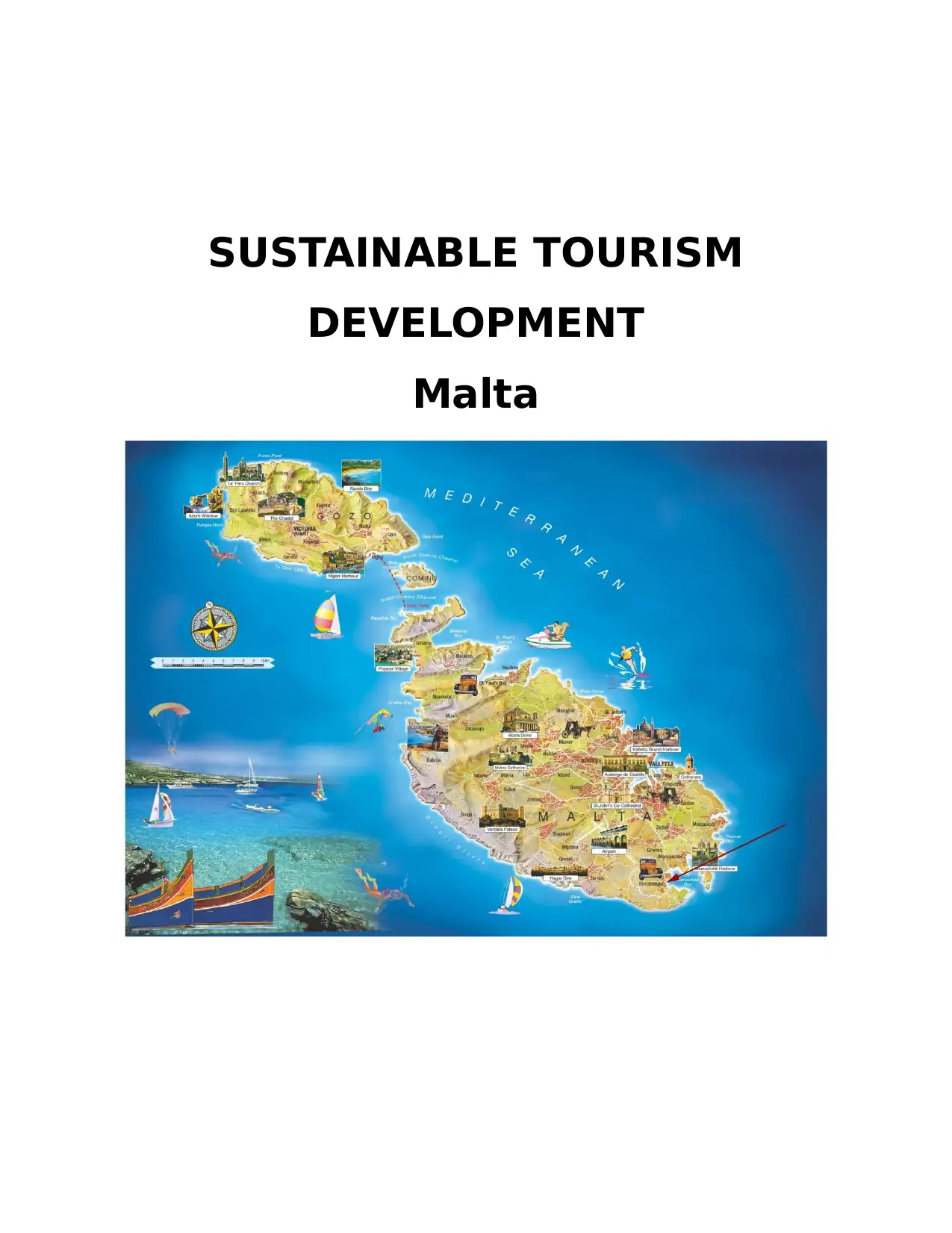
SUSTAINABLE TOURISM
DEVELOPMENT
Malta
DEVELOPMENT
Malta
Paraphrase This Document
Need a fresh take? Get an instant paraphrase of this document with our AI Paraphraser
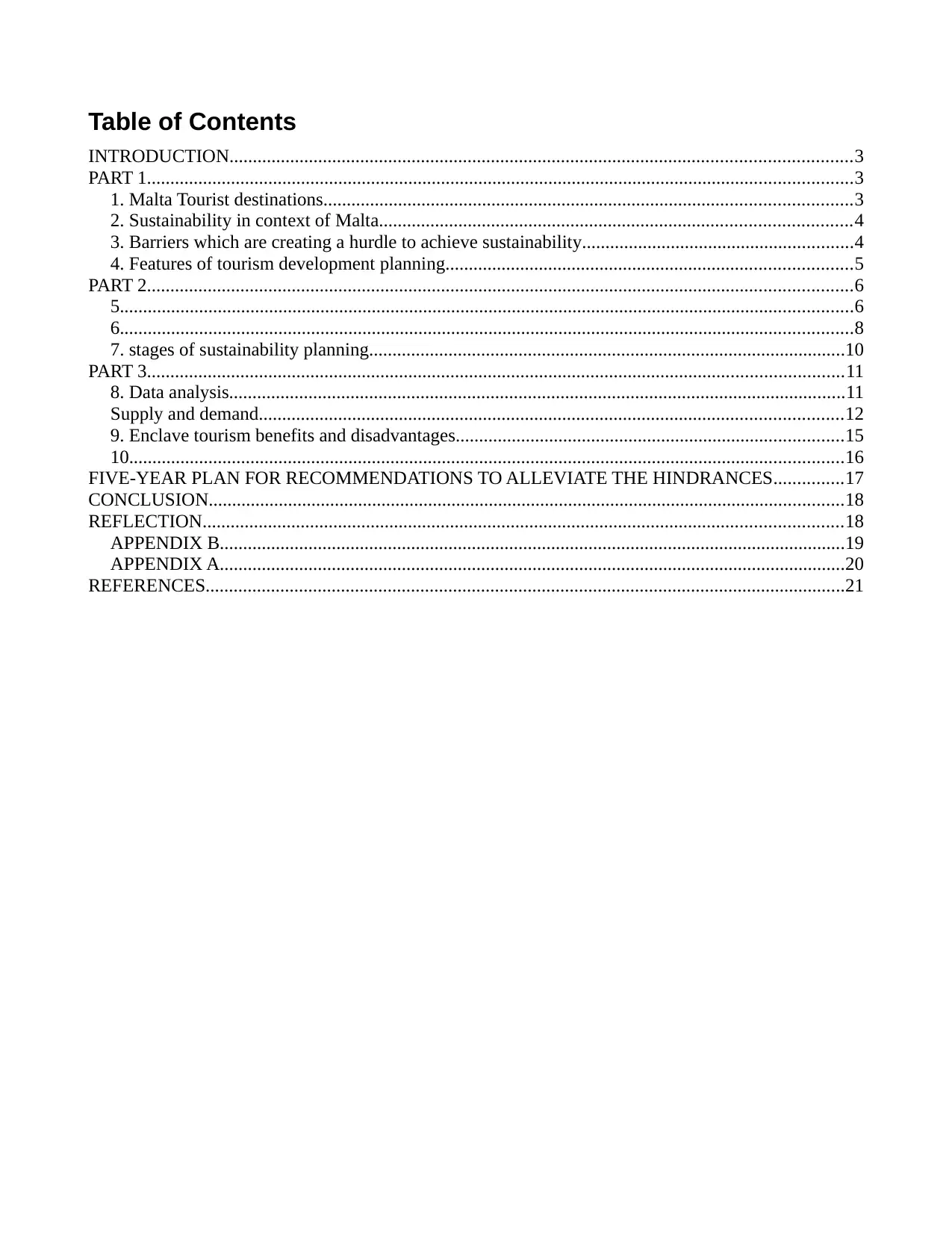
Table of Contents
INTRODUCTION.....................................................................................................................................3
PART 1.......................................................................................................................................................3
1. Malta Tourist destinations.................................................................................................................3
2. Sustainability in context of Malta.....................................................................................................4
3. Barriers which are creating a hurdle to achieve sustainability..........................................................4
4. Features of tourism development planning.......................................................................................5
PART 2.......................................................................................................................................................6
5.............................................................................................................................................................6
6.............................................................................................................................................................8
7. stages of sustainability planning......................................................................................................10
PART 3.....................................................................................................................................................11
8. Data analysis....................................................................................................................................11
Supply and demand.............................................................................................................................12
9. Enclave tourism benefits and disadvantages...................................................................................15
10.........................................................................................................................................................16
FIVE-YEAR PLAN FOR RECOMMENDATIONS TO ALLEVIATE THE HINDRANCES...............17
CONCLUSION........................................................................................................................................18
REFLECTION.........................................................................................................................................18
APPENDIX B......................................................................................................................................19
APPENDIX A......................................................................................................................................20
REFERENCES.........................................................................................................................................21
INTRODUCTION.....................................................................................................................................3
PART 1.......................................................................................................................................................3
1. Malta Tourist destinations.................................................................................................................3
2. Sustainability in context of Malta.....................................................................................................4
3. Barriers which are creating a hurdle to achieve sustainability..........................................................4
4. Features of tourism development planning.......................................................................................5
PART 2.......................................................................................................................................................6
5.............................................................................................................................................................6
6.............................................................................................................................................................8
7. stages of sustainability planning......................................................................................................10
PART 3.....................................................................................................................................................11
8. Data analysis....................................................................................................................................11
Supply and demand.............................................................................................................................12
9. Enclave tourism benefits and disadvantages...................................................................................15
10.........................................................................................................................................................16
FIVE-YEAR PLAN FOR RECOMMENDATIONS TO ALLEVIATE THE HINDRANCES...............17
CONCLUSION........................................................................................................................................18
REFLECTION.........................................................................................................................................18
APPENDIX B......................................................................................................................................19
APPENDIX A......................................................................................................................................20
REFERENCES.........................................................................................................................................21
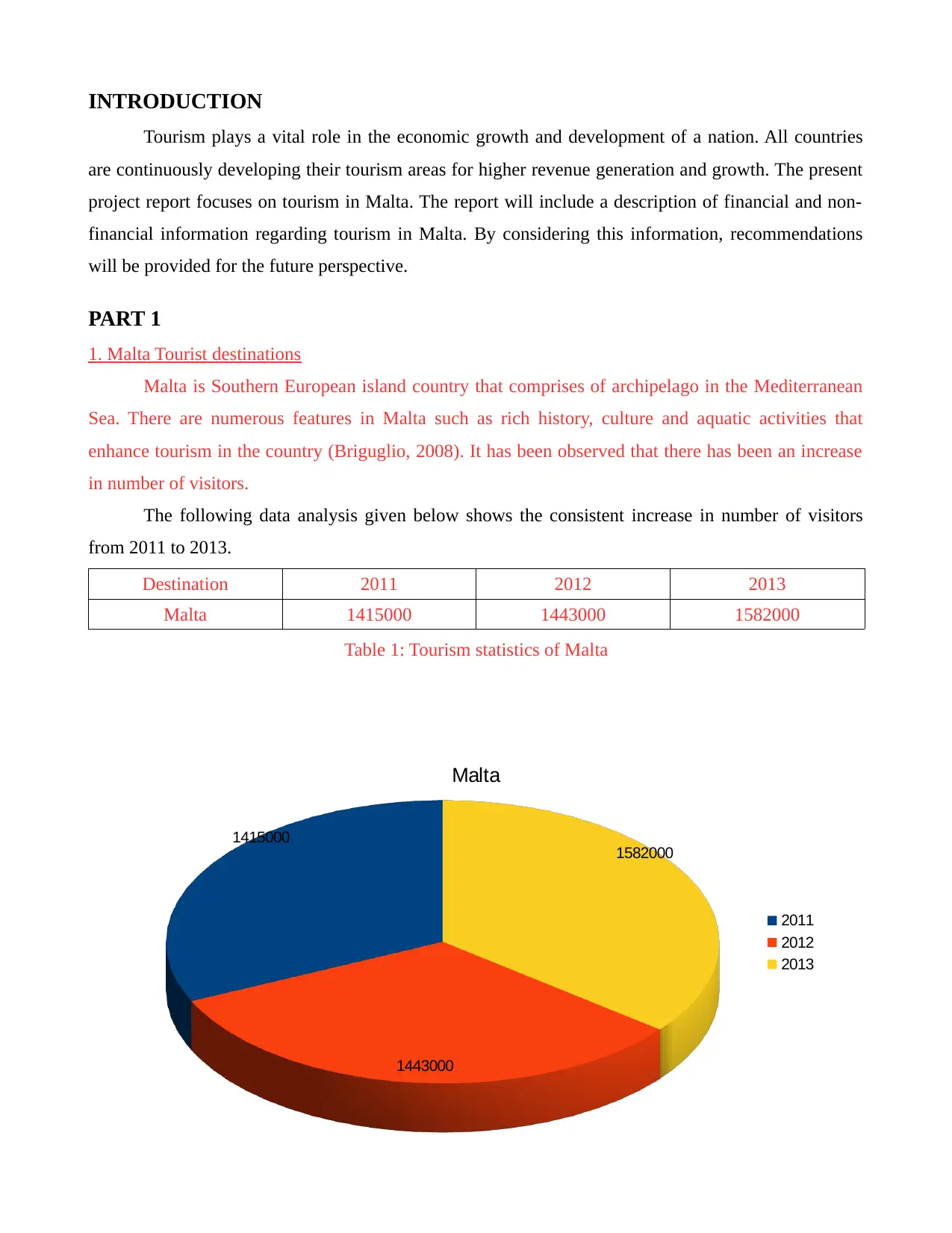
INTRODUCTION
Tourism plays a vital role in the economic growth and development of a nation. All countries
are continuously developing their tourism areas for higher revenue generation and growth. The present
project report focuses on tourism in Malta. The report will include a description of financial and non-
financial information regarding tourism in Malta. By considering this information, recommendations
will be provided for the future perspective.
PART 1
1. Malta Tourist destinations
Malta is Southern European island country that comprises of archipelago in the Mediterranean
Sea. There are numerous features in Malta such as rich history, culture and aquatic activities that
enhance tourism in the country (Briguglio, 2008). It has been observed that there has been an increase
in number of visitors.
The following data analysis given below shows the consistent increase in number of visitors
from 2011 to 2013.
Destination 2011 2012 2013
Malta 1415000 1443000 1582000
Table 1: Tourism statistics of Malta
1415000
1443000
1582000
Malta
2011
2012
2013
Tourism plays a vital role in the economic growth and development of a nation. All countries
are continuously developing their tourism areas for higher revenue generation and growth. The present
project report focuses on tourism in Malta. The report will include a description of financial and non-
financial information regarding tourism in Malta. By considering this information, recommendations
will be provided for the future perspective.
PART 1
1. Malta Tourist destinations
Malta is Southern European island country that comprises of archipelago in the Mediterranean
Sea. There are numerous features in Malta such as rich history, culture and aquatic activities that
enhance tourism in the country (Briguglio, 2008). It has been observed that there has been an increase
in number of visitors.
The following data analysis given below shows the consistent increase in number of visitors
from 2011 to 2013.
Destination 2011 2012 2013
Malta 1415000 1443000 1582000
Table 1: Tourism statistics of Malta
1415000
1443000
1582000
Malta
2011
2012
2013
⊘ This is a preview!⊘
Do you want full access?
Subscribe today to unlock all pages.

Trusted by 1+ million students worldwide
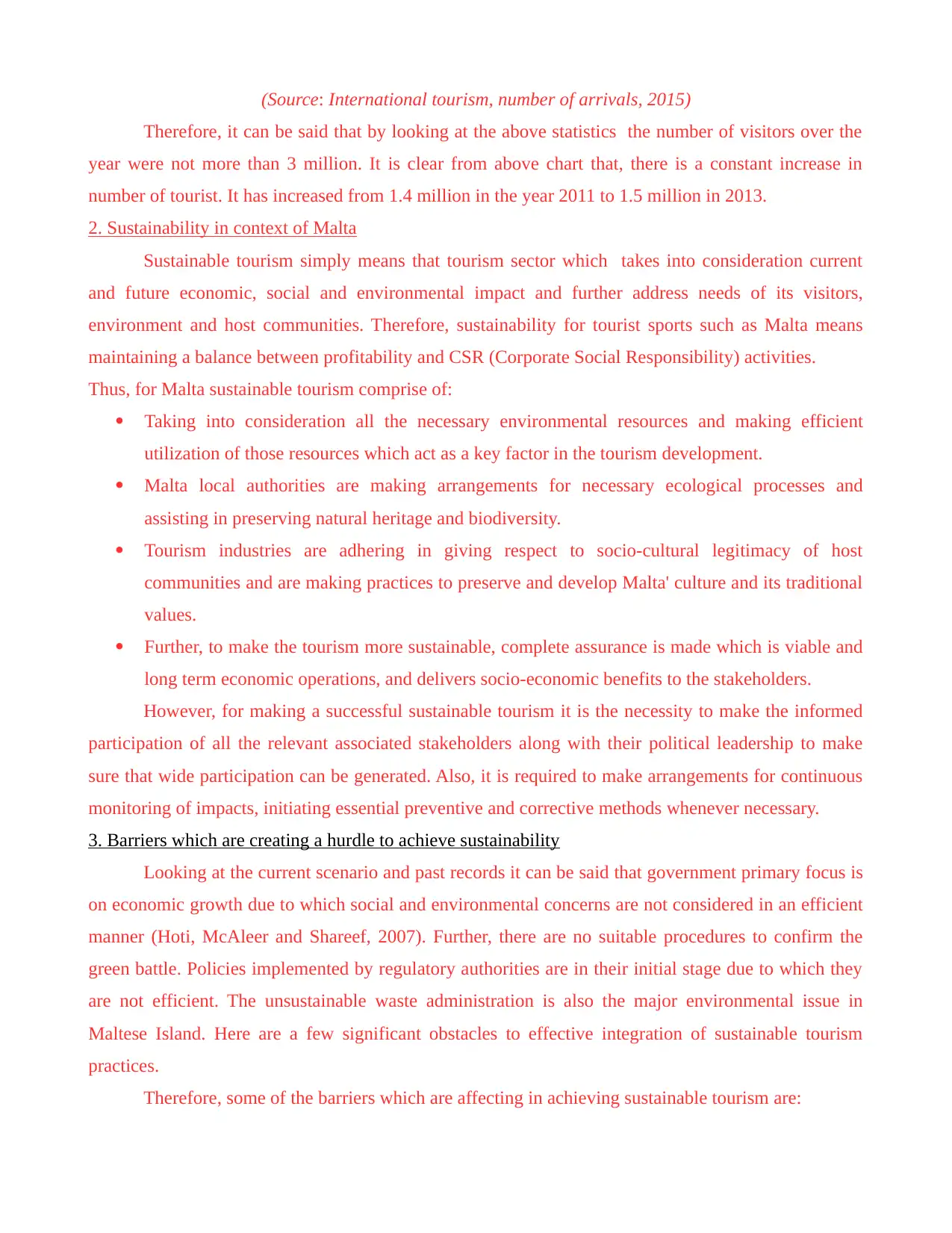
(Source: International tourism, number of arrivals, 2015)
Therefore, it can be said that by looking at the above statistics the number of visitors over the
year were not more than 3 million. It is clear from above chart that, there is a constant increase in
number of tourist. It has increased from 1.4 million in the year 2011 to 1.5 million in 2013.
2. Sustainability in context of Malta
Sustainable tourism simply means that tourism sector which takes into consideration current
and future economic, social and environmental impact and further address needs of its visitors,
environment and host communities. Therefore, sustainability for tourist sports such as Malta means
maintaining a balance between profitability and CSR (Corporate Social Responsibility) activities.
Thus, for Malta sustainable tourism comprise of:
Taking into consideration all the necessary environmental resources and making efficient
utilization of those resources which act as a key factor in the tourism development.
Malta local authorities are making arrangements for necessary ecological processes and
assisting in preserving natural heritage and biodiversity.
Tourism industries are adhering in giving respect to socio-cultural legitimacy of host
communities and are making practices to preserve and develop Malta' culture and its traditional
values.
Further, to make the tourism more sustainable, complete assurance is made which is viable and
long term economic operations, and delivers socio-economic benefits to the stakeholders.
However, for making a successful sustainable tourism it is the necessity to make the informed
participation of all the relevant associated stakeholders along with their political leadership to make
sure that wide participation can be generated. Also, it is required to make arrangements for continuous
monitoring of impacts, initiating essential preventive and corrective methods whenever necessary.
3. Barriers which are creating a hurdle to achieve sustainability
Looking at the current scenario and past records it can be said that government primary focus is
on economic growth due to which social and environmental concerns are not considered in an efficient
manner (Hoti, McAleer and Shareef, 2007). Further, there are no suitable procedures to confirm the
green battle. Policies implemented by regulatory authorities are in their initial stage due to which they
are not efficient. The unsustainable waste administration is also the major environmental issue in
Maltese Island. Here are a few significant obstacles to effective integration of sustainable tourism
practices.
Therefore, some of the barriers which are affecting in achieving sustainable tourism are:
Therefore, it can be said that by looking at the above statistics the number of visitors over the
year were not more than 3 million. It is clear from above chart that, there is a constant increase in
number of tourist. It has increased from 1.4 million in the year 2011 to 1.5 million in 2013.
2. Sustainability in context of Malta
Sustainable tourism simply means that tourism sector which takes into consideration current
and future economic, social and environmental impact and further address needs of its visitors,
environment and host communities. Therefore, sustainability for tourist sports such as Malta means
maintaining a balance between profitability and CSR (Corporate Social Responsibility) activities.
Thus, for Malta sustainable tourism comprise of:
Taking into consideration all the necessary environmental resources and making efficient
utilization of those resources which act as a key factor in the tourism development.
Malta local authorities are making arrangements for necessary ecological processes and
assisting in preserving natural heritage and biodiversity.
Tourism industries are adhering in giving respect to socio-cultural legitimacy of host
communities and are making practices to preserve and develop Malta' culture and its traditional
values.
Further, to make the tourism more sustainable, complete assurance is made which is viable and
long term economic operations, and delivers socio-economic benefits to the stakeholders.
However, for making a successful sustainable tourism it is the necessity to make the informed
participation of all the relevant associated stakeholders along with their political leadership to make
sure that wide participation can be generated. Also, it is required to make arrangements for continuous
monitoring of impacts, initiating essential preventive and corrective methods whenever necessary.
3. Barriers which are creating a hurdle to achieve sustainability
Looking at the current scenario and past records it can be said that government primary focus is
on economic growth due to which social and environmental concerns are not considered in an efficient
manner (Hoti, McAleer and Shareef, 2007). Further, there are no suitable procedures to confirm the
green battle. Policies implemented by regulatory authorities are in their initial stage due to which they
are not efficient. The unsustainable waste administration is also the major environmental issue in
Maltese Island. Here are a few significant obstacles to effective integration of sustainable tourism
practices.
Therefore, some of the barriers which are affecting in achieving sustainable tourism are:
Paraphrase This Document
Need a fresh take? Get an instant paraphrase of this document with our AI Paraphraser
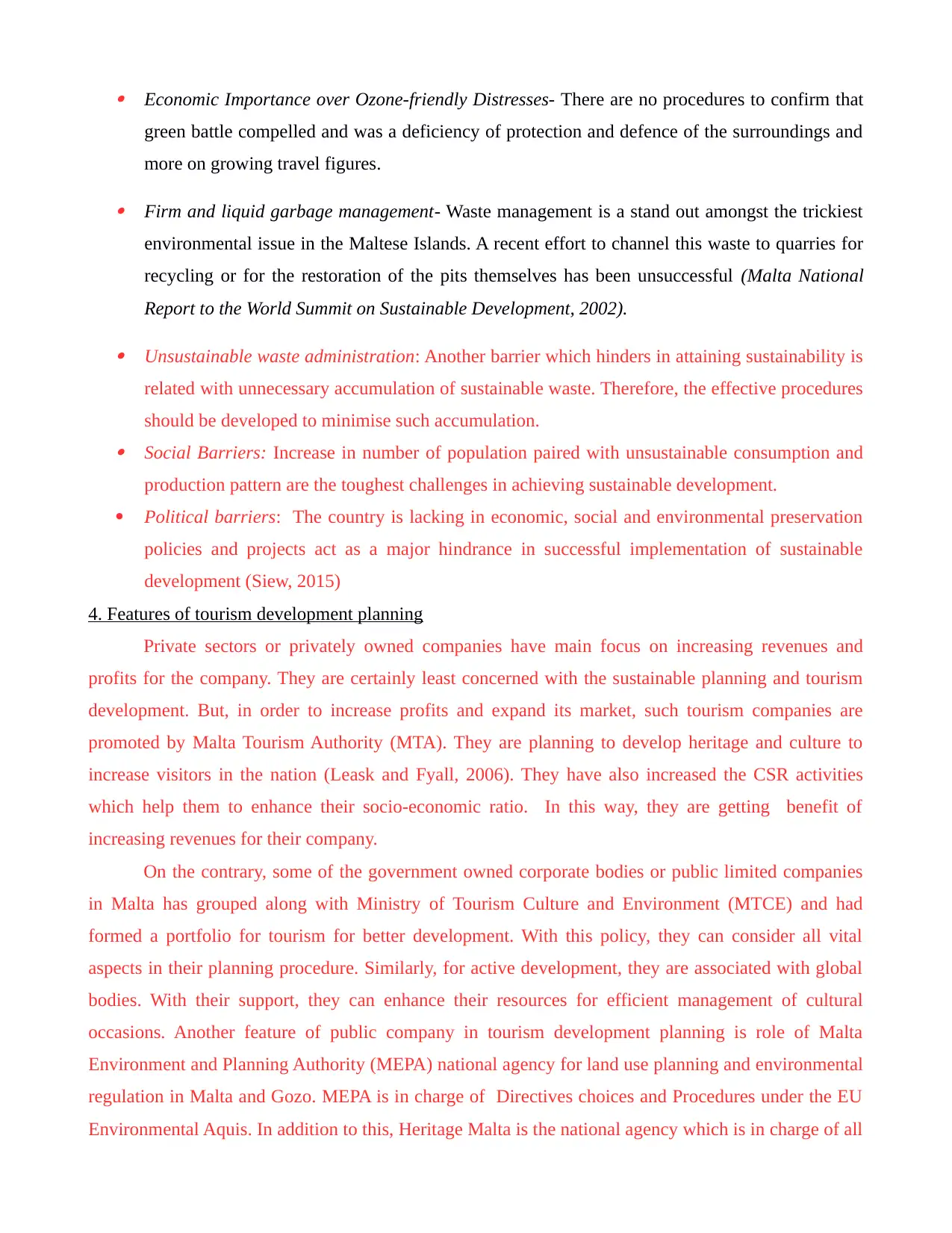
Economic Importance over Ozone-friendly Distresses- There are no procedures to confirm that
green battle compelled and was a deficiency of protection and defence of the surroundings and
more on growing travel figures.
Firm and liquid garbage management- Waste management is a stand out amongst the trickiest
environmental issue in the Maltese Islands. A recent effort to channel this waste to quarries for
recycling or for the restoration of the pits themselves has been unsuccessful (Malta National
Report to the World Summit on Sustainable Development, 2002).
Unsustainable waste administration: Another barrier which hinders in attaining sustainability is
related with unnecessary accumulation of sustainable waste. Therefore, the effective procedures
should be developed to minimise such accumulation. Social Barriers: Increase in number of population paired with unsustainable consumption and
production pattern are the toughest challenges in achieving sustainable development.
Political barriers: The country is lacking in economic, social and environmental preservation
policies and projects act as a major hindrance in successful implementation of sustainable
development (Siew, 2015)
4. Features of tourism development planning
Private sectors or privately owned companies have main focus on increasing revenues and
profits for the company. They are certainly least concerned with the sustainable planning and tourism
development. But, in order to increase profits and expand its market, such tourism companies are
promoted by Malta Tourism Authority (MTA). They are planning to develop heritage and culture to
increase visitors in the nation (Leask and Fyall, 2006). They have also increased the CSR activities
which help them to enhance their socio-economic ratio. In this way, they are getting benefit of
increasing revenues for their company.
On the contrary, some of the government owned corporate bodies or public limited companies
in Malta has grouped along with Ministry of Tourism Culture and Environment (MTCE) and had
formed a portfolio for tourism for better development. With this policy, they can consider all vital
aspects in their planning procedure. Similarly, for active development, they are associated with global
bodies. With their support, they can enhance their resources for efficient management of cultural
occasions. Another feature of public company in tourism development planning is role of Malta
Environment and Planning Authority (MEPA) national agency for land use planning and environmental
regulation in Malta and Gozo. MEPA is in charge of Directives choices and Procedures under the EU
Environmental Aquis. In addition to this, Heritage Malta is the national agency which is in charge of all
green battle compelled and was a deficiency of protection and defence of the surroundings and
more on growing travel figures.
Firm and liquid garbage management- Waste management is a stand out amongst the trickiest
environmental issue in the Maltese Islands. A recent effort to channel this waste to quarries for
recycling or for the restoration of the pits themselves has been unsuccessful (Malta National
Report to the World Summit on Sustainable Development, 2002).
Unsustainable waste administration: Another barrier which hinders in attaining sustainability is
related with unnecessary accumulation of sustainable waste. Therefore, the effective procedures
should be developed to minimise such accumulation. Social Barriers: Increase in number of population paired with unsustainable consumption and
production pattern are the toughest challenges in achieving sustainable development.
Political barriers: The country is lacking in economic, social and environmental preservation
policies and projects act as a major hindrance in successful implementation of sustainable
development (Siew, 2015)
4. Features of tourism development planning
Private sectors or privately owned companies have main focus on increasing revenues and
profits for the company. They are certainly least concerned with the sustainable planning and tourism
development. But, in order to increase profits and expand its market, such tourism companies are
promoted by Malta Tourism Authority (MTA). They are planning to develop heritage and culture to
increase visitors in the nation (Leask and Fyall, 2006). They have also increased the CSR activities
which help them to enhance their socio-economic ratio. In this way, they are getting benefit of
increasing revenues for their company.
On the contrary, some of the government owned corporate bodies or public limited companies
in Malta has grouped along with Ministry of Tourism Culture and Environment (MTCE) and had
formed a portfolio for tourism for better development. With this policy, they can consider all vital
aspects in their planning procedure. Similarly, for active development, they are associated with global
bodies. With their support, they can enhance their resources for efficient management of cultural
occasions. Another feature of public company in tourism development planning is role of Malta
Environment and Planning Authority (MEPA) national agency for land use planning and environmental
regulation in Malta and Gozo. MEPA is in charge of Directives choices and Procedures under the EU
Environmental Aquis. In addition to this, Heritage Malta is the national agency which is in charge of all
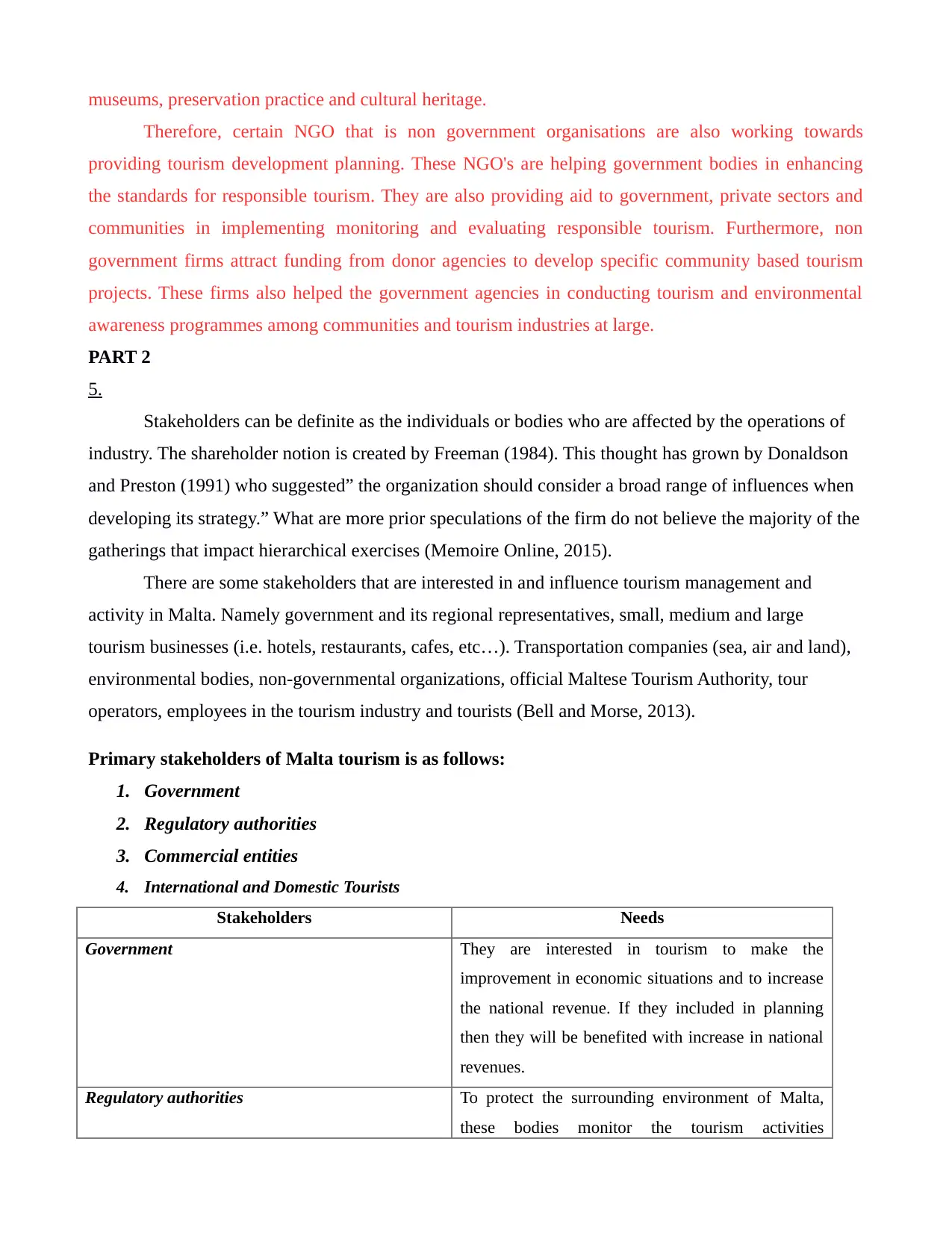
museums, preservation practice and cultural heritage.
Therefore, certain NGO that is non government organisations are also working towards
providing tourism development planning. These NGO's are helping government bodies in enhancing
the standards for responsible tourism. They are also providing aid to government, private sectors and
communities in implementing monitoring and evaluating responsible tourism. Furthermore, non
government firms attract funding from donor agencies to develop specific community based tourism
projects. These firms also helped the government agencies in conducting tourism and environmental
awareness programmes among communities and tourism industries at large.
PART 2
5.
Stakeholders can be definite as the individuals or bodies who are affected by the operations of
industry. The shareholder notion is created by Freeman (1984). This thought has grown by Donaldson
and Preston (1991) who suggested” the organization should consider a broad range of influences when
developing its strategy.” What are more prior speculations of the firm do not believe the majority of the
gatherings that impact hierarchical exercises (Memoire Online, 2015).
There are some stakeholders that are interested in and influence tourism management and
activity in Malta. Namely government and its regional representatives, small, medium and large
tourism businesses (i.e. hotels, restaurants, cafes, etc…). Transportation companies (sea, air and land),
environmental bodies, non-governmental organizations, official Maltese Tourism Authority, tour
operators, employees in the tourism industry and tourists (Bell and Morse, 2013).
Primary stakeholders of Malta tourism is as follows:
1. Government
2. Regulatory authorities
3. Commercial entities
4. International and Domestic Tourists
Stakeholders Needs
Government They are interested in tourism to make the
improvement in economic situations and to increase
the national revenue. If they included in planning
then they will be benefited with increase in national
revenues.
Regulatory authorities To protect the surrounding environment of Malta,
these bodies monitor the tourism activities
Therefore, certain NGO that is non government organisations are also working towards
providing tourism development planning. These NGO's are helping government bodies in enhancing
the standards for responsible tourism. They are also providing aid to government, private sectors and
communities in implementing monitoring and evaluating responsible tourism. Furthermore, non
government firms attract funding from donor agencies to develop specific community based tourism
projects. These firms also helped the government agencies in conducting tourism and environmental
awareness programmes among communities and tourism industries at large.
PART 2
5.
Stakeholders can be definite as the individuals or bodies who are affected by the operations of
industry. The shareholder notion is created by Freeman (1984). This thought has grown by Donaldson
and Preston (1991) who suggested” the organization should consider a broad range of influences when
developing its strategy.” What are more prior speculations of the firm do not believe the majority of the
gatherings that impact hierarchical exercises (Memoire Online, 2015).
There are some stakeholders that are interested in and influence tourism management and
activity in Malta. Namely government and its regional representatives, small, medium and large
tourism businesses (i.e. hotels, restaurants, cafes, etc…). Transportation companies (sea, air and land),
environmental bodies, non-governmental organizations, official Maltese Tourism Authority, tour
operators, employees in the tourism industry and tourists (Bell and Morse, 2013).
Primary stakeholders of Malta tourism is as follows:
1. Government
2. Regulatory authorities
3. Commercial entities
4. International and Domestic Tourists
Stakeholders Needs
Government They are interested in tourism to make the
improvement in economic situations and to increase
the national revenue. If they included in planning
then they will be benefited with increase in national
revenues.
Regulatory authorities To protect the surrounding environment of Malta,
these bodies monitor the tourism activities
⊘ This is a preview!⊘
Do you want full access?
Subscribe today to unlock all pages.

Trusted by 1+ million students worldwide
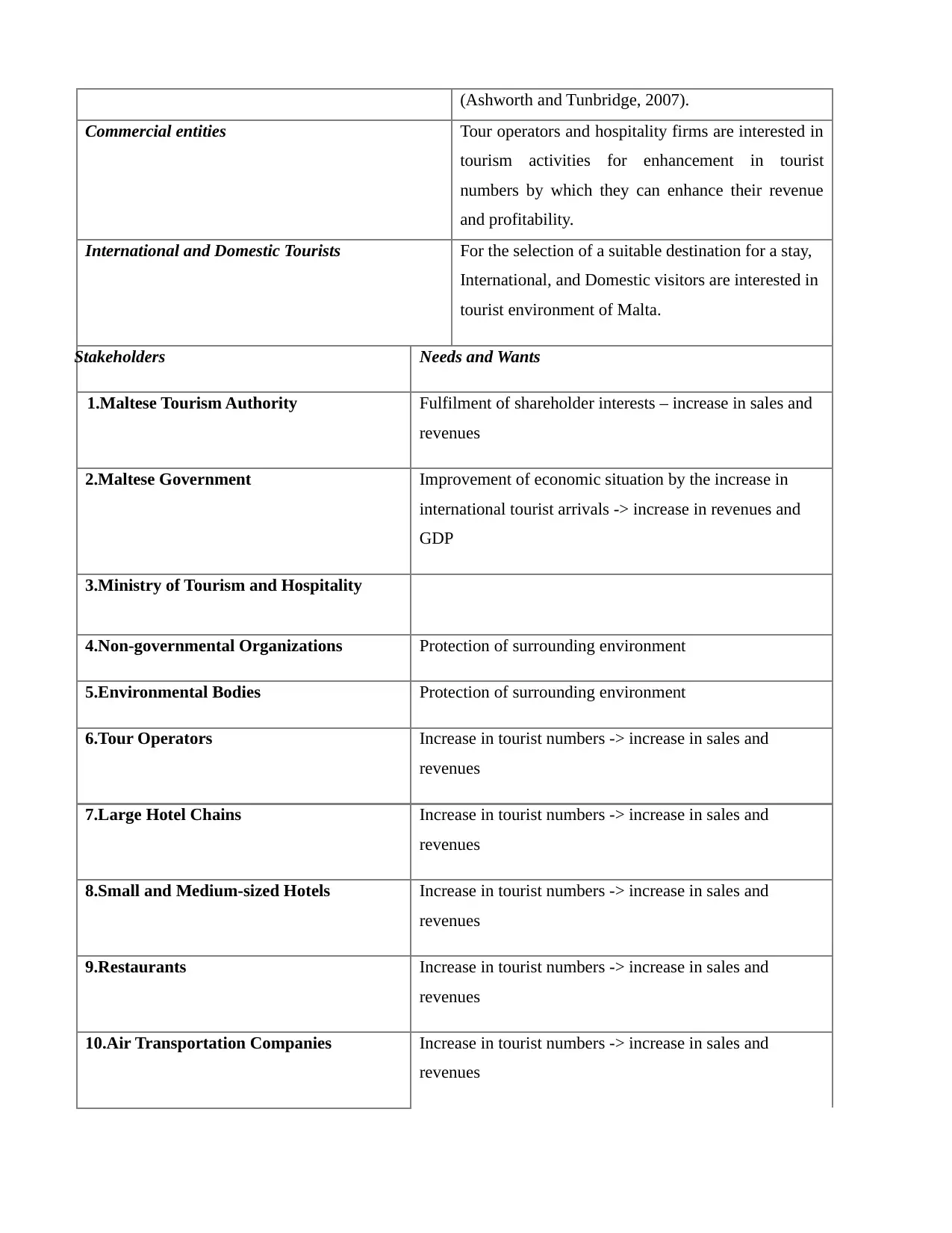
(Ashworth and Tunbridge, 2007).
Commercial entities Tour operators and hospitality firms are interested in
tourism activities for enhancement in tourist
numbers by which they can enhance their revenue
and profitability.
International and Domestic Tourists For the selection of a suitable destination for a stay,
International, and Domestic visitors are interested in
tourist environment of Malta.
Stakeholders Needs and Wants
1.Maltese Tourism Authority Fulfilment of shareholder interests – increase in sales and
revenues
2.Maltese Government Improvement of economic situation by the increase in
international tourist arrivals -> increase in revenues and
GDP
3.Ministry of Tourism and Hospitality
4.Non-governmental Organizations Protection of surrounding environment
5.Environmental Bodies Protection of surrounding environment
6.Tour Operators Increase in tourist numbers -> increase in sales and
revenues
7.Large Hotel Chains Increase in tourist numbers -> increase in sales and
revenues
8.Small and Medium-sized Hotels Increase in tourist numbers -> increase in sales and
revenues
9.Restaurants Increase in tourist numbers -> increase in sales and
revenues
10.Air Transportation Companies Increase in tourist numbers -> increase in sales and
revenues
Commercial entities Tour operators and hospitality firms are interested in
tourism activities for enhancement in tourist
numbers by which they can enhance their revenue
and profitability.
International and Domestic Tourists For the selection of a suitable destination for a stay,
International, and Domestic visitors are interested in
tourist environment of Malta.
Stakeholders Needs and Wants
1.Maltese Tourism Authority Fulfilment of shareholder interests – increase in sales and
revenues
2.Maltese Government Improvement of economic situation by the increase in
international tourist arrivals -> increase in revenues and
GDP
3.Ministry of Tourism and Hospitality
4.Non-governmental Organizations Protection of surrounding environment
5.Environmental Bodies Protection of surrounding environment
6.Tour Operators Increase in tourist numbers -> increase in sales and
revenues
7.Large Hotel Chains Increase in tourist numbers -> increase in sales and
revenues
8.Small and Medium-sized Hotels Increase in tourist numbers -> increase in sales and
revenues
9.Restaurants Increase in tourist numbers -> increase in sales and
revenues
10.Air Transportation Companies Increase in tourist numbers -> increase in sales and
revenues
Paraphrase This Document
Need a fresh take? Get an instant paraphrase of this document with our AI Paraphraser
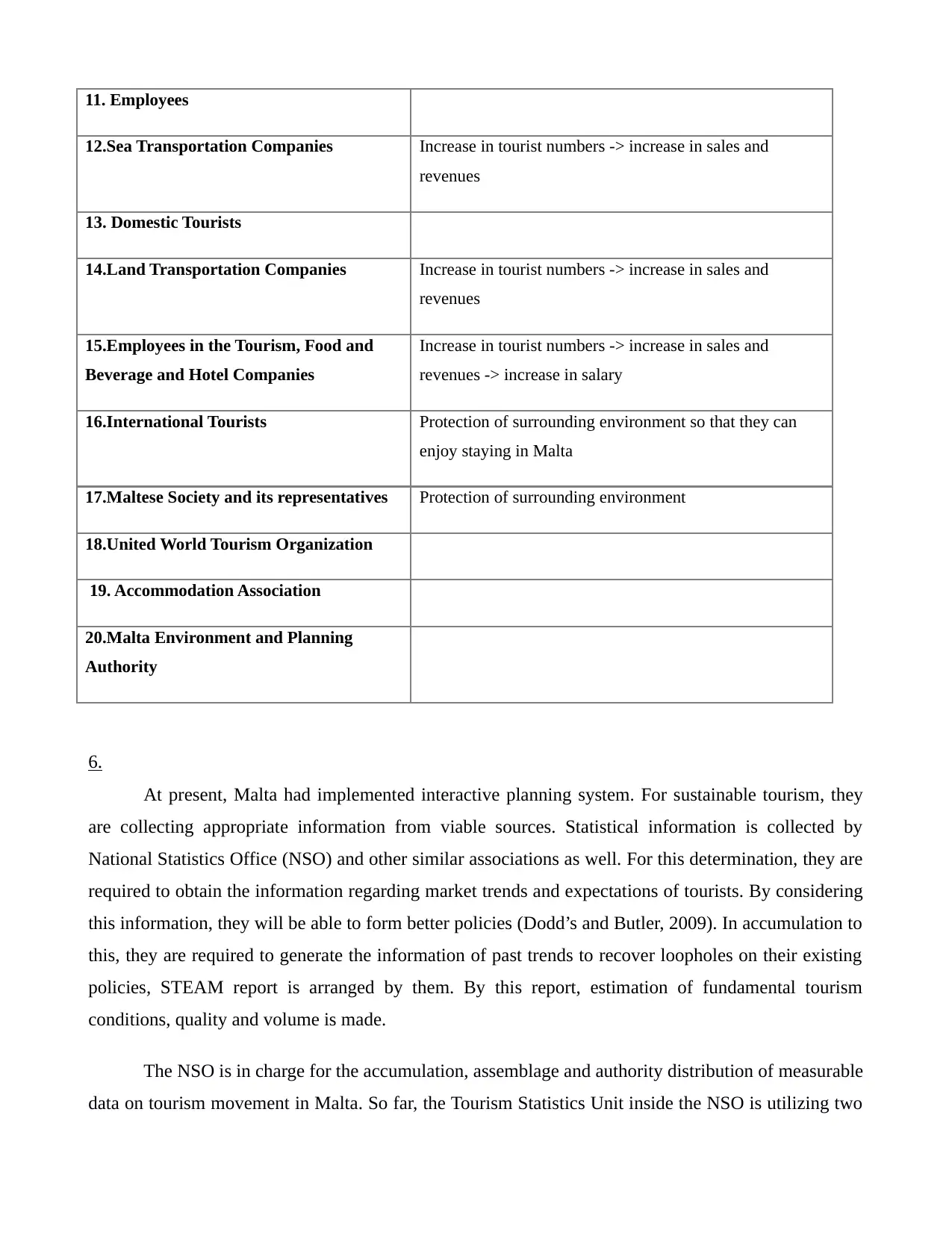
11. Employees
12.Sea Transportation Companies Increase in tourist numbers -> increase in sales and
revenues
13. Domestic Tourists
14.Land Transportation Companies Increase in tourist numbers -> increase in sales and
revenues
15.Employees in the Tourism, Food and
Beverage and Hotel Companies
Increase in tourist numbers -> increase in sales and
revenues -> increase in salary
16.International Tourists Protection of surrounding environment so that they can
enjoy staying in Malta
17.Maltese Society and its representatives Protection of surrounding environment
18.United World Tourism Organization
19. Accommodation Association
20.Malta Environment and Planning
Authority
6.
At present, Malta had implemented interactive planning system. For sustainable tourism, they
are collecting appropriate information from viable sources. Statistical information is collected by
National Statistics Office (NSO) and other similar associations as well. For this determination, they are
required to obtain the information regarding market trends and expectations of tourists. By considering
this information, they will be able to form better policies (Dodd’s and Butler, 2009). In accumulation to
this, they are required to generate the information of past trends to recover loopholes on their existing
policies, STEAM report is arranged by them. By this report, estimation of fundamental tourism
conditions, quality and volume is made.
The NSO is in charge for the accumulation, assemblage and authority distribution of measurable
data on tourism movement in Malta. So far, the Tourism Statistics Unit inside the NSO is utilizing two
12.Sea Transportation Companies Increase in tourist numbers -> increase in sales and
revenues
13. Domestic Tourists
14.Land Transportation Companies Increase in tourist numbers -> increase in sales and
revenues
15.Employees in the Tourism, Food and
Beverage and Hotel Companies
Increase in tourist numbers -> increase in sales and
revenues -> increase in salary
16.International Tourists Protection of surrounding environment so that they can
enjoy staying in Malta
17.Maltese Society and its representatives Protection of surrounding environment
18.United World Tourism Organization
19. Accommodation Association
20.Malta Environment and Planning
Authority
6.
At present, Malta had implemented interactive planning system. For sustainable tourism, they
are collecting appropriate information from viable sources. Statistical information is collected by
National Statistics Office (NSO) and other similar associations as well. For this determination, they are
required to obtain the information regarding market trends and expectations of tourists. By considering
this information, they will be able to form better policies (Dodd’s and Butler, 2009). In accumulation to
this, they are required to generate the information of past trends to recover loopholes on their existing
policies, STEAM report is arranged by them. By this report, estimation of fundamental tourism
conditions, quality and volume is made.
The NSO is in charge for the accumulation, assemblage and authority distribution of measurable
data on tourism movement in Malta. So far, the Tourism Statistics Unit inside the NSO is utilizing two
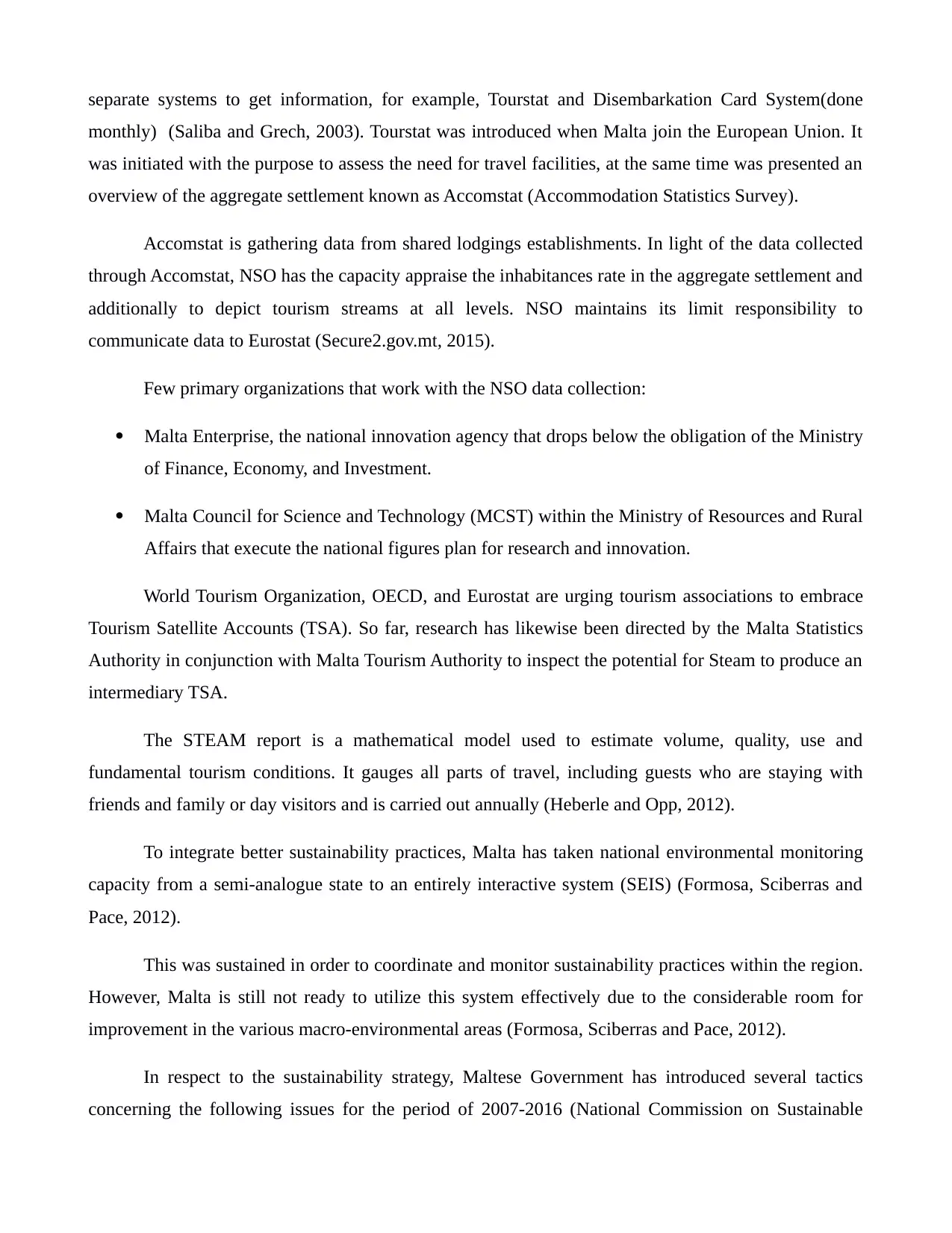
separate systems to get information, for example, Tourstat and Disembarkation Card System(done
monthly) (Saliba and Grech, 2003). Tourstat was introduced when Malta join the European Union. It
was initiated with the purpose to assess the need for travel facilities, at the same time was presented an
overview of the aggregate settlement known as Accomstat (Accommodation Statistics Survey).
Accomstat is gathering data from shared lodgings establishments. In light of the data collected
through Accomstat, NSO has the capacity appraise the inhabitances rate in the aggregate settlement and
additionally to depict tourism streams at all levels. NSO maintains its limit responsibility to
communicate data to Eurostat (Secure2.gov.mt, 2015).
Few primary organizations that work with the NSO data collection:
Malta Enterprise, the national innovation agency that drops below the obligation of the Ministry
of Finance, Economy, and Investment.
Malta Council for Science and Technology (MCST) within the Ministry of Resources and Rural
Affairs that execute the national figures plan for research and innovation.
World Tourism Organization, OECD, and Eurostat are urging tourism associations to embrace
Tourism Satellite Accounts (TSA). So far, research has likewise been directed by the Malta Statistics
Authority in conjunction with Malta Tourism Authority to inspect the potential for Steam to produce an
intermediary TSA.
The STEAM report is a mathematical model used to estimate volume, quality, use and
fundamental tourism conditions. It gauges all parts of travel, including guests who are staying with
friends and family or day visitors and is carried out annually (Heberle and Opp, 2012).
To integrate better sustainability practices, Malta has taken national environmental monitoring
capacity from a semi-analogue state to an entirely interactive system (SEIS) (Formosa, Sciberras and
Pace, 2012).
This was sustained in order to coordinate and monitor sustainability practices within the region.
However, Malta is still not ready to utilize this system effectively due to the considerable room for
improvement in the various macro-environmental areas (Formosa, Sciberras and Pace, 2012).
In respect to the sustainability strategy, Maltese Government has introduced several tactics
concerning the following issues for the period of 2007-2016 (National Commission on Sustainable
monthly) (Saliba and Grech, 2003). Tourstat was introduced when Malta join the European Union. It
was initiated with the purpose to assess the need for travel facilities, at the same time was presented an
overview of the aggregate settlement known as Accomstat (Accommodation Statistics Survey).
Accomstat is gathering data from shared lodgings establishments. In light of the data collected
through Accomstat, NSO has the capacity appraise the inhabitances rate in the aggregate settlement and
additionally to depict tourism streams at all levels. NSO maintains its limit responsibility to
communicate data to Eurostat (Secure2.gov.mt, 2015).
Few primary organizations that work with the NSO data collection:
Malta Enterprise, the national innovation agency that drops below the obligation of the Ministry
of Finance, Economy, and Investment.
Malta Council for Science and Technology (MCST) within the Ministry of Resources and Rural
Affairs that execute the national figures plan for research and innovation.
World Tourism Organization, OECD, and Eurostat are urging tourism associations to embrace
Tourism Satellite Accounts (TSA). So far, research has likewise been directed by the Malta Statistics
Authority in conjunction with Malta Tourism Authority to inspect the potential for Steam to produce an
intermediary TSA.
The STEAM report is a mathematical model used to estimate volume, quality, use and
fundamental tourism conditions. It gauges all parts of travel, including guests who are staying with
friends and family or day visitors and is carried out annually (Heberle and Opp, 2012).
To integrate better sustainability practices, Malta has taken national environmental monitoring
capacity from a semi-analogue state to an entirely interactive system (SEIS) (Formosa, Sciberras and
Pace, 2012).
This was sustained in order to coordinate and monitor sustainability practices within the region.
However, Malta is still not ready to utilize this system effectively due to the considerable room for
improvement in the various macro-environmental areas (Formosa, Sciberras and Pace, 2012).
In respect to the sustainability strategy, Maltese Government has introduced several tactics
concerning the following issues for the period of 2007-2016 (National Commission on Sustainable
⊘ This is a preview!⊘
Do you want full access?
Subscribe today to unlock all pages.

Trusted by 1+ million students worldwide
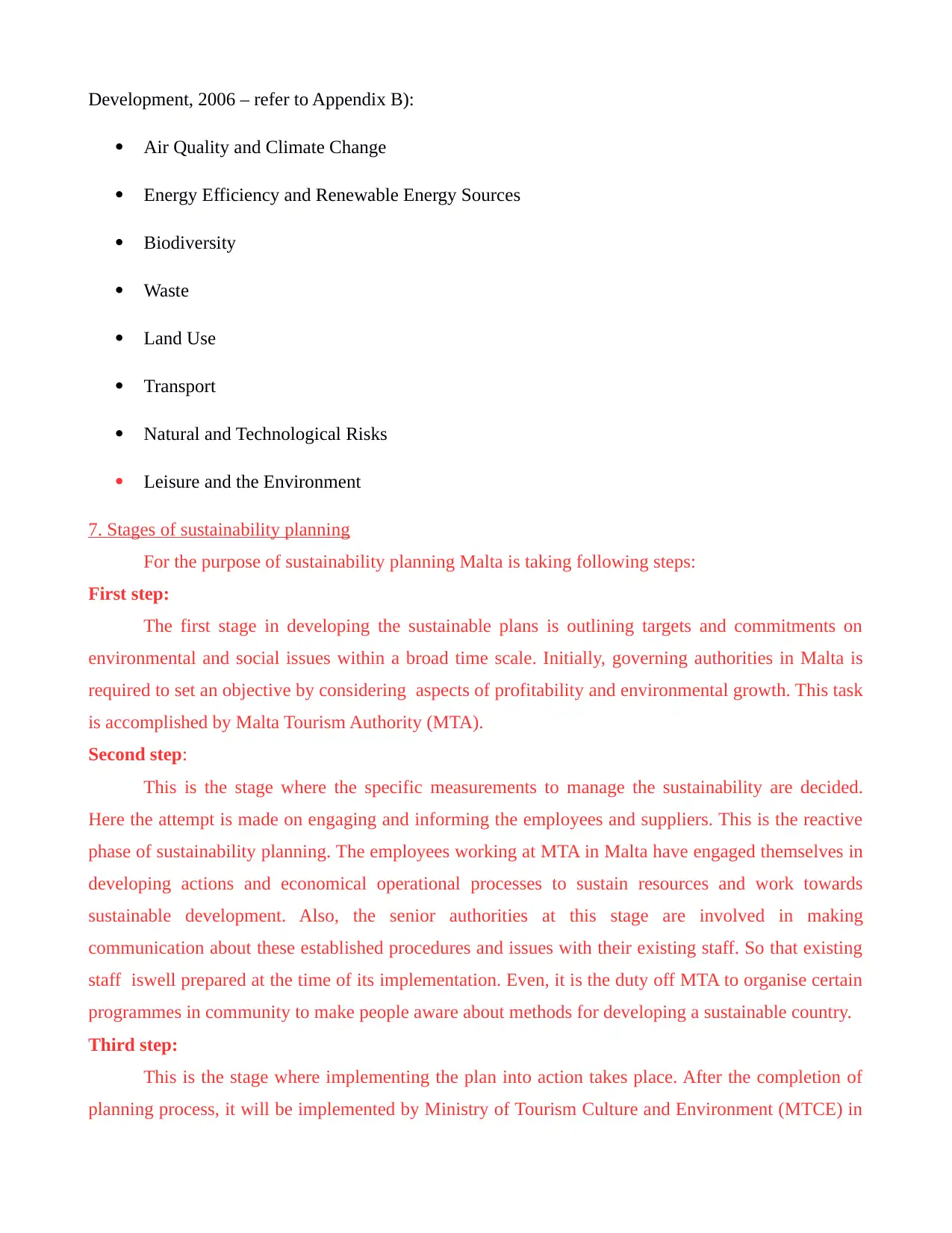
Development, 2006 – refer to Appendix B):
Air Quality and Climate Change
Energy Efficiency and Renewable Energy Sources
Biodiversity
Waste
Land Use
Transport
Natural and Technological Risks
Leisure and the Environment
7. Stages of sustainability planning
For the purpose of sustainability planning Malta is taking following steps:
First step:
The first stage in developing the sustainable plans is outlining targets and commitments on
environmental and social issues within a broad time scale. Initially, governing authorities in Malta is
required to set an objective by considering aspects of profitability and environmental growth. This task
is accomplished by Malta Tourism Authority (MTA).
Second step:
This is the stage where the specific measurements to manage the sustainability are decided.
Here the attempt is made on engaging and informing the employees and suppliers. This is the reactive
phase of sustainability planning. The employees working at MTA in Malta have engaged themselves in
developing actions and economical operational processes to sustain resources and work towards
sustainable development. Also, the senior authorities at this stage are involved in making
communication about these established procedures and issues with their existing staff. So that existing
staff iswell prepared at the time of its implementation. Even, it is the duty off MTA to organise certain
programmes in community to make people aware about methods for developing a sustainable country.
Third step:
This is the stage where implementing the plan into action takes place. After the completion of
planning process, it will be implemented by Ministry of Tourism Culture and Environment (MTCE) in
Air Quality and Climate Change
Energy Efficiency and Renewable Energy Sources
Biodiversity
Waste
Land Use
Transport
Natural and Technological Risks
Leisure and the Environment
7. Stages of sustainability planning
For the purpose of sustainability planning Malta is taking following steps:
First step:
The first stage in developing the sustainable plans is outlining targets and commitments on
environmental and social issues within a broad time scale. Initially, governing authorities in Malta is
required to set an objective by considering aspects of profitability and environmental growth. This task
is accomplished by Malta Tourism Authority (MTA).
Second step:
This is the stage where the specific measurements to manage the sustainability are decided.
Here the attempt is made on engaging and informing the employees and suppliers. This is the reactive
phase of sustainability planning. The employees working at MTA in Malta have engaged themselves in
developing actions and economical operational processes to sustain resources and work towards
sustainable development. Also, the senior authorities at this stage are involved in making
communication about these established procedures and issues with their existing staff. So that existing
staff iswell prepared at the time of its implementation. Even, it is the duty off MTA to organise certain
programmes in community to make people aware about methods for developing a sustainable country.
Third step:
This is the stage where implementing the plan into action takes place. After the completion of
planning process, it will be implemented by Ministry of Tourism Culture and Environment (MTCE) in
Paraphrase This Document
Need a fresh take? Get an instant paraphrase of this document with our AI Paraphraser
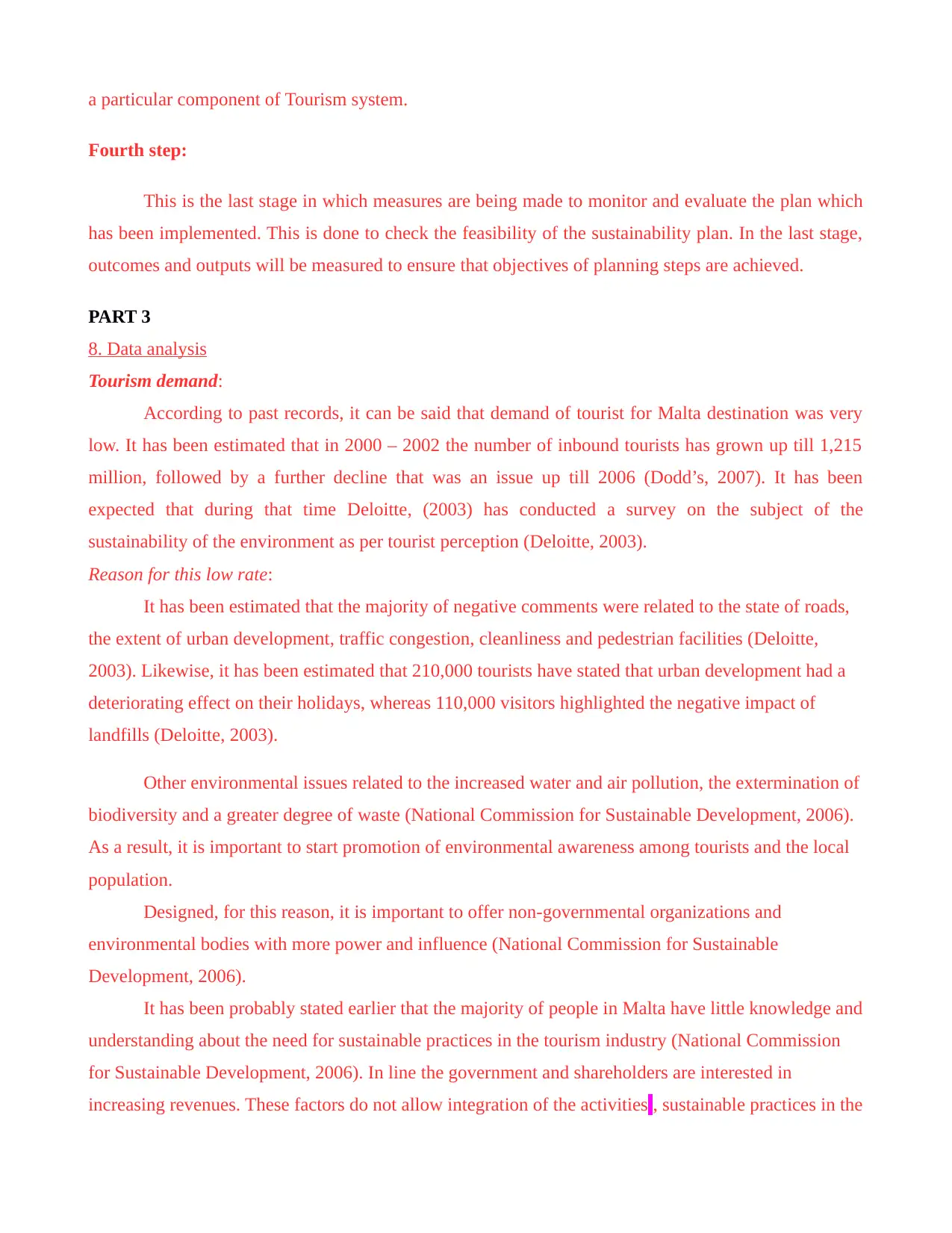
a particular component of Tourism system.
Fourth step:
This is the last stage in which measures are being made to monitor and evaluate the plan which
has been implemented. This is done to check the feasibility of the sustainability plan. In the last stage,
outcomes and outputs will be measured to ensure that objectives of planning steps are achieved.
PART 3
8. Data analysis
Tourism demand:
According to past records, it can be said that demand of tourist for Malta destination was very
low. It has been estimated that in 2000 – 2002 the number of inbound tourists has grown up till 1,215
million, followed by a further decline that was an issue up till 2006 (Dodd’s, 2007). It has been
expected that during that time Deloitte, (2003) has conducted a survey on the subject of the
sustainability of the environment as per tourist perception (Deloitte, 2003).
Reason for this low rate:
It has been estimated that the majority of negative comments were related to the state of roads,
the extent of urban development, traffic congestion, cleanliness and pedestrian facilities (Deloitte,
2003). Likewise, it has been estimated that 210,000 tourists have stated that urban development had a
deteriorating effect on their holidays, whereas 110,000 visitors highlighted the negative impact of
landfills (Deloitte, 2003).
Other environmental issues related to the increased water and air pollution, the extermination of
biodiversity and a greater degree of waste (National Commission for Sustainable Development, 2006).
As a result, it is important to start promotion of environmental awareness among tourists and the local
population.
Designed, for this reason, it is important to offer non-governmental organizations and
environmental bodies with more power and influence (National Commission for Sustainable
Development, 2006).
It has been probably stated earlier that the majority of people in Malta have little knowledge and
understanding about the need for sustainable practices in the tourism industry (National Commission
for Sustainable Development, 2006). In line the government and shareholders are interested in
increasing revenues. These factors do not allow integration of the activities , sustainable practices in the
Fourth step:
This is the last stage in which measures are being made to monitor and evaluate the plan which
has been implemented. This is done to check the feasibility of the sustainability plan. In the last stage,
outcomes and outputs will be measured to ensure that objectives of planning steps are achieved.
PART 3
8. Data analysis
Tourism demand:
According to past records, it can be said that demand of tourist for Malta destination was very
low. It has been estimated that in 2000 – 2002 the number of inbound tourists has grown up till 1,215
million, followed by a further decline that was an issue up till 2006 (Dodd’s, 2007). It has been
expected that during that time Deloitte, (2003) has conducted a survey on the subject of the
sustainability of the environment as per tourist perception (Deloitte, 2003).
Reason for this low rate:
It has been estimated that the majority of negative comments were related to the state of roads,
the extent of urban development, traffic congestion, cleanliness and pedestrian facilities (Deloitte,
2003). Likewise, it has been estimated that 210,000 tourists have stated that urban development had a
deteriorating effect on their holidays, whereas 110,000 visitors highlighted the negative impact of
landfills (Deloitte, 2003).
Other environmental issues related to the increased water and air pollution, the extermination of
biodiversity and a greater degree of waste (National Commission for Sustainable Development, 2006).
As a result, it is important to start promotion of environmental awareness among tourists and the local
population.
Designed, for this reason, it is important to offer non-governmental organizations and
environmental bodies with more power and influence (National Commission for Sustainable
Development, 2006).
It has been probably stated earlier that the majority of people in Malta have little knowledge and
understanding about the need for sustainable practices in the tourism industry (National Commission
for Sustainable Development, 2006). In line the government and shareholders are interested in
increasing revenues. These factors do not allow integration of the activities , sustainable practices in the
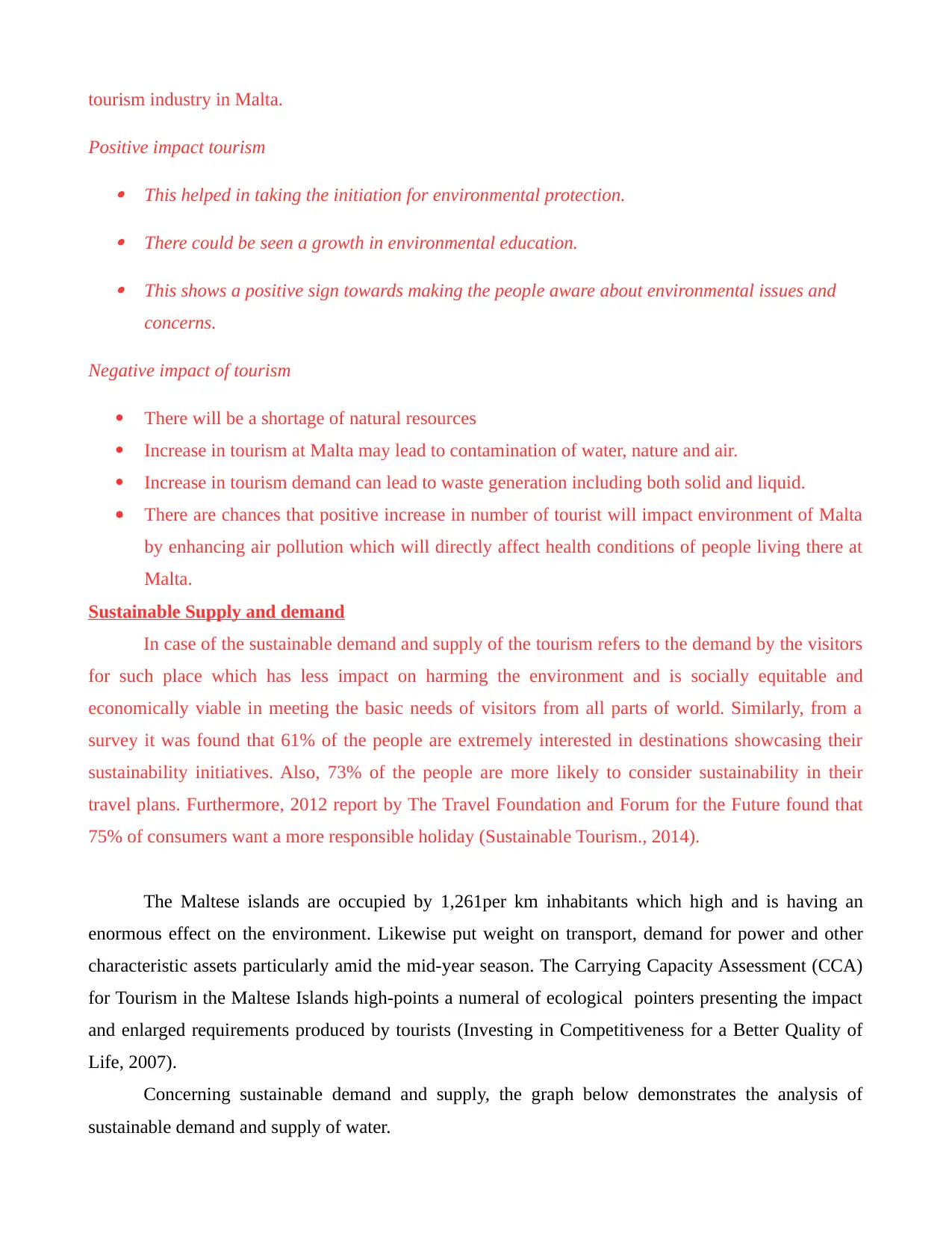
tourism industry in Malta.
Positive impact tourism
This helped in taking the initiation for environmental protection.
There could be seen a growth in environmental education.
This shows a positive sign towards making the people aware about environmental issues and
concerns.
Negative impact of tourism
There will be a shortage of natural resources
Increase in tourism at Malta may lead to contamination of water, nature and air.
Increase in tourism demand can lead to waste generation including both solid and liquid.
There are chances that positive increase in number of tourist will impact environment of Malta
by enhancing air pollution which will directly affect health conditions of people living there at
Malta.
Sustainable Supply and demand
In case of the sustainable demand and supply of the tourism refers to the demand by the visitors
for such place which has less impact on harming the environment and is socially equitable and
economically viable in meeting the basic needs of visitors from all parts of world. Similarly, from a
survey it was found that 61% of the people are extremely interested in destinations showcasing their
sustainability initiatives. Also, 73% of the people are more likely to consider sustainability in their
travel plans. Furthermore, 2012 report by The Travel Foundation and Forum for the Future found that
75% of consumers want a more responsible holiday (Sustainable Tourism., 2014).
The Maltese islands are occupied by 1,261per km inhabitants which high and is having an
enormous effect on the environment. Likewise put weight on transport, demand for power and other
characteristic assets particularly amid the mid-year season. The Carrying Capacity Assessment (CCA)
for Tourism in the Maltese Islands high-points a numeral of ecological pointers presenting the impact
and enlarged requirements produced by tourists (Investing in Competitiveness for a Better Quality of
Life, 2007).
Concerning sustainable demand and supply, the graph below demonstrates the analysis of
sustainable demand and supply of water.
Positive impact tourism
This helped in taking the initiation for environmental protection.
There could be seen a growth in environmental education.
This shows a positive sign towards making the people aware about environmental issues and
concerns.
Negative impact of tourism
There will be a shortage of natural resources
Increase in tourism at Malta may lead to contamination of water, nature and air.
Increase in tourism demand can lead to waste generation including both solid and liquid.
There are chances that positive increase in number of tourist will impact environment of Malta
by enhancing air pollution which will directly affect health conditions of people living there at
Malta.
Sustainable Supply and demand
In case of the sustainable demand and supply of the tourism refers to the demand by the visitors
for such place which has less impact on harming the environment and is socially equitable and
economically viable in meeting the basic needs of visitors from all parts of world. Similarly, from a
survey it was found that 61% of the people are extremely interested in destinations showcasing their
sustainability initiatives. Also, 73% of the people are more likely to consider sustainability in their
travel plans. Furthermore, 2012 report by The Travel Foundation and Forum for the Future found that
75% of consumers want a more responsible holiday (Sustainable Tourism., 2014).
The Maltese islands are occupied by 1,261per km inhabitants which high and is having an
enormous effect on the environment. Likewise put weight on transport, demand for power and other
characteristic assets particularly amid the mid-year season. The Carrying Capacity Assessment (CCA)
for Tourism in the Maltese Islands high-points a numeral of ecological pointers presenting the impact
and enlarged requirements produced by tourists (Investing in Competitiveness for a Better Quality of
Life, 2007).
Concerning sustainable demand and supply, the graph below demonstrates the analysis of
sustainable demand and supply of water.
⊘ This is a preview!⊘
Do you want full access?
Subscribe today to unlock all pages.

Trusted by 1+ million students worldwide
1 out of 25
Related Documents
Your All-in-One AI-Powered Toolkit for Academic Success.
+13062052269
info@desklib.com
Available 24*7 on WhatsApp / Email
![[object Object]](/_next/static/media/star-bottom.7253800d.svg)
Unlock your academic potential
Copyright © 2020–2025 A2Z Services. All Rights Reserved. Developed and managed by ZUCOL.





